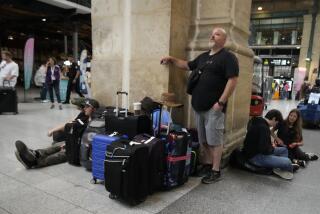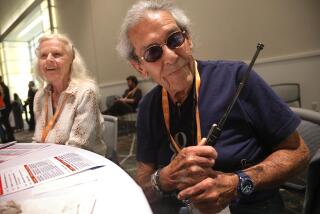After Carnage, a Return to Routine
ALCALA, Spain — It was three bombs hidden in backpacks that blasted apart the 7 a.m. train to Madrid a week ago. But most people on the platform at Alcala station this Thursday morning seem to be carrying some kind of bag as they scurry through the predawn gloom to catch the train.
All those backpacks and purses, briefcases and computer bags no longer look like innocent accessories. Still, the rhythms of life demand a return to some definition of normal, and those who survived that doomed 39-minute ride have started making the trip again.
They flow past the lone police officer on duty at Alcala, conscripts to the tight schedules of a commuter’s life, and hurry to beat the closing doors.
“I saw so many things that day that I want to forget,” says Jean Sima, a 32-year-old Romanian immigrant who works in Madrid as a welder, standing in a door well. He has taken the train at the same time every workday for the last “two years and one month,” he says.
He demonstrates how he stepped over shattered bodies. Thirty-five people died on the train.
He wasn’t injured but was too upset to get back on the train right after the bombing.
The train has only a few dozen passengers as it leaves Alcala, a comfortable town east of Madrid previously famous as the birthplace of Miguel de Cervantes, author of “Don Quixote.” Canned music plays softly over the loudspeakers. Two young men shove enormous backpacks onto the overhead racks.
“I don’t want to take the train, but I have no choice. I have to get to work,” 27-year-old Mirella Toea says softly. She, too, is from Romania, working as a cleaner for a woman in Madrid. Many Romanian workers ride the early trains; 29 are believed to have died in the bombings.
Toea couldn’t face the trip the day after the bombing either and says she “cried all the way to work on Monday.” Her eyes fill with tears in the telling.
She is working illegally in Spain but has read in the papers that the government is offering citizenship to survivors. “I don’t care about getting papers,” she says. “What do I want papers for?”
“I could be dead,” she says. “I could be missing an arm.”
The darkness has surrendered to a faint misty light, exposing a scruffy landscape.
The train passes a factory and low-rise apartment buildings and stops at Vicalvaro, a blue-collar neighborhood. Manual laborers step aboard, men wearing thick jackets standing next to women dressed smartly for the office. Chatter drowns out the music.
“I always travel in the same car,” says Alicia Gutierrez, 30, who works for the Chamber of Commerce in Madrid. Habit may have saved her. Three of her colleagues were killed when a bomb exploded in the adjacent car.
More bombs were planted in three trains that left Alcala at five minute intervals after the 7 a.m. service, exploding at other stations along the route.
Gutierrez tells of the hush that fell over the passengers during Monday’s ride as the train passed through two stations that had been hit -- Santa Eugenia and El Pozo.
“People were crying when we went through the stations that had the bombs,” she says. Gutierrez says she recognizes faces of those who regularly take the train -- familiarity without friendship -- but they remain strangers despite their shared trauma. “No, we didn’t talk about it,” she says. “The silence was striking.”
The train is now cramped as it enters the fringes of Madrid. The windows fog up from the passengers’ breath, but the red lights of an early traffic jam are visible as the train passes over a highway into downtown. People clutch their packs and shuffle in search of some space.
Michel Godinez, a 23-year-old Cuban student wearing a Chicago Bulls jacket, has boarded at El Pozo. He takes this train into Madrid to go to classes every Thursday.
Except last Thursday. The university was closed that day because of a strike, and he slept in. He heard the explosion at El Pozo from his bed, a 10-minute walk away. “If there hadn’t been a strike, many, many more students would have died,” he says.
The train slows and slinks into a tunnel. Atocha is next.
Gutierrez says she is terribly frightened to travel. “I am always looking for backpacks,” she says. “I know I really can’t do anything [to stop another attack]. But I am always checking the overhead racks anyway.” The backpack bombs that destroyed her train are believed to have been left under a seat.
The red digital lettering above the doors says 7:38 when the train brakes to a stop in Atocha. Gutierrez gets off, as do most passengers, flooding the platform. There is a dash of color in a gray scene: Candles in red plastic cups surround the base of the standards that rise to identify track numbers and destinations. Mourners have twisted flowers around the poles, and there are photographs and letters to the victims.
Atocha is an enormous station, an architectural hybrid of industrial-age red brick and modern glass that is a hub for connecting trains and buses.
One flight up, at street level, more candles have been lit.
They blanket the station lobby, giving off an intense heat. Mixed among them are more notes and poems to those slain in the banal routine of the morning commute.
“One morning like any other,” reads one ode to the dead. “See you later, they said.”
*
Special correspondent Cristina Mateo-Yanguas contributed to this report.
More to Read
Sign up for Essential California
The most important California stories and recommendations in your inbox every morning.
You may occasionally receive promotional content from the Los Angeles Times.










